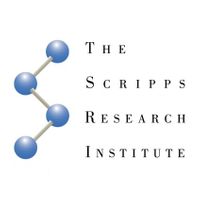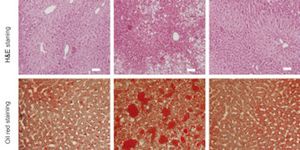
Authors of the new eLife study include (left to right) Luke Wiseman, Jeffery Kelly, Lars Plate and Ryan Paxman of The Scripps Research Institute.
LA JOLLA, CA – July 20, 2016 – In a new study, scientists at The Scripps Research Institute (TSRI) have identified drug candidates that can boost a cell’s ability to catch the “typos” in protein production that can cause a deadly disease called amyloidosis.
“This study reveals a new approach to intervene in human disease,” said Luke Wiseman, assistant professor at TSRI and co-senior author of the new research with Jeffery Kelly, Lita Annenberg Hazen Professor of Chemistry at TSRI.
The research was published today in the journal eLife.
A New Approach
Every human cell houses a little factory called the endoplasmic reticulum (ER), where proteins are folded into their proper three-dimensional shape before exiting a cell.
When the ER notices a typo in these proteins—a misfolding event—it recruits “chaperone” proteins to catch the misfolded proteins before they enter the bloodstream and form toxic clusters, or amyloid. Amyloid deposits in the heart, liver, retina or other organs in amyloidosis diseases lead to the degeneration of these tissues.
Unfortunately, there sometimes aren’t enough chaperones to catch all misfolded proteins. To fix this, scientists are looking at possible strategies to activate the ER’s Unfolded Protein Response (UPR), a signaling network that tells cells to produce more chaperone proteins to enhance editing or protein quality control.
“We’re trying to make these helpers more efficient,” said Kelly, who also serves as chairman of the Department of Molecular and Experimental Medicine and is a member of the Skaggs Institute for Chemical Biology at TSRI.
But there’s a catch to this approach—the cell will die if all three signaling “arms” of the UPR are activated for too long.
However, an intriguing 2014 study from the Wiseman and Kelly labs indicated there may be a way to activate just one “arm” of the UPR, the ATF6 pathway, to catch misfolded proteins without triggering cell death. For the new study, the researchers teamed up with TSRI’s Molecular Screening Center, on the institute’s Florida campus, to pursue this potential approach to developing new therapies.
Narrowing the Field
From a library of hundreds of thousands of molecules, the researchers identified almost 14,000 molecules that could potentially interact with ATF6. The team then narrowed down this library using a technique called multiple gene expression profiling, eventually ending up with 79 potential molecules that activate the ATF6 arm of the UPR.
Next, the researchers asked the key question: “Which molecules would preferentially activate ATF6 without launching the entire UPR network?”
To figure this out, the researchers used an approach called transcriptional profiling, which allowed the scientists to see if the molecules were really targeting just the ATF6 arm of the UPR.
The researchers then prioritized eight promising “structural families”—templates for compounds that appeared effective. TSRI Graduate Student Ryan J. Paxman led the effort to synthesize compounds from these families for confirmation and to understand how they activate ATF6.
Fine-Tuning Future Therapies
In experiments with human liver and plasma cells, the researchers found that several of the compounds could “phenocopy,” or mimic, a cell’s normal activation of AFT6—leading to the generation of chaperone proteins that could help prevent misfolding events associated with disease.
Interestingly, these compounds activated ATF6 to different extents—even causing slight activation of the other UPR arms in some cases. The researchers compared these compounds to rheostat knobs, carefully tuning certain cellular pathways up and down.
For example, one compound activated ATF6 at about 40 percent, yet that was enough to produce a beneficial response from the ER in two models of human amyloid disease.
“Now we can fine-tune the ER quality-control process,” said TSRI Research Associate Lars Plate, who was co-first author of the study with Christina B. Cooley, a TSRI research associate at the time of the study, now an assistant professor at Trinity University.
The next steps will be to test several other small molecules as potential drug candidates and develop models to study these compounds in different diseases where protein secretion plays a role.
“This is a class of drugs that could also work for diabetes and additional neurodegenerative diseases linked to protein misfolding, like Alzheimer’s disease,” said Kelly.
In addition to Wiseman, Kelly, Paxman, Plate and Cooley, authors of the study “
Small Molecule Proteostasis Regulators that Reprogram the ER to Reduce Extracellular Protein Aggregation,” were John J. Chen, Evan T. Powers, Steven J. Brown and Hugh Rosen of TSRI’s California campus; Timothy P. Spicer and Louis Scampavia of TSRI’s Florida campus; Joseph C. Genereux, previously at TSRI, now at the University of California, Riverside; Frank Madoux and Peter Hodder, previously at TSRI, now at Amgen, Inc.; Ciara M. Gallagher and Peter Walter of the Howard Hughes Medical Institute and the University of California, San Francisco; Wesley Dobbs and Dan Garza of Proteostasis Therapeutics Inc.
This study was supported by the National Institutes of Health (grant AG046495, DK102635, DK046335, DK107604, 749 NS092829 and F32 AG042259), Arlene and Arnold Goldstein, the Amyloidosis Foundation, the Skaggs Institute for Chemical Biology and the Leukemia and Lymphoma Society.
This article was originally published on
Scripps.edu.









